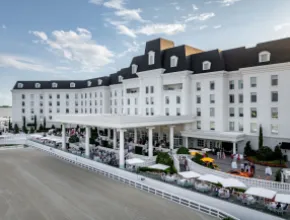The Orange County coast is a sun-drenched parade of coastal cities that exemplify most people’s perception of Southern California—and a look beneath the surface reveals a host of cultural sites and up-to-date meeting facilities that will hold attendees’ attention, at least until the next time surf’s up.
Huntington Beach
Huntington Beach is Orange County’s largest beach city and offers visitors close proximity to major attractions such as Disneyland and Knott’s Berry Farm. But it is primarily an outdoorsy, oceanside community, a legacy the city certified by trademarking the name “Surf City USA.”
Stroll the beaches, check out the pier, visit all the migrating birds that land at Bolsa Chica Ecological Reserve—then head to the Huntington Beach Art Center for contemporary art, or check out Duke Kahanamoku’s surfboard and other bits of surfing history at the International Surfing Museum and Surfers’ Hall of Fame.
“We also have some amazing conference resort hotels [with] four-star service levels that are able to deliver the service and experience attendees demand,” says Chris Anderson, director of sales at the Huntington Beach Marketing and Visitors Bureau.
Meetings-friendly properties include the Hyatt Regency Huntington Beach Resort & Spa, the Hilton-flagged Waterfront Beach Resort and the Shorebreak Hotel.
Planners can have part of retail-rich 5th Street closed for events, which can include concerts, movie premieres and morning yoga sessions. Near Huntington Beach Pier, an outdoor amphitheater provides planners with another option for sessions along the shore.
Newport Beach
Newport Beach surrounds beautiful Newport Harbor and extends inland through the Back Bay, a salt lagoon. Although it’s one of America’s wealthier cities, Newport’s range of lodgings suits a variety of budgets, says Vicki Higgins, senior vice president of marketing at Visit Newport Beach.
“They might think it’s too crazy for their pocketbook, but we pride ourselves on having something that fits every budget,” Higgins says, noting that Newport Beach’s current planner promotion, “Live the Dream,” lets planners know that the Southern California lifestyle, with its attractive climate, oceanside villas, luxury dining experiences and relaxing spas, is very much alive.
Newport has 400 restaurants, and major hotel chains are well-represented. While the Radisson Hotel Newport Beach and Fairmont Newport Beach are closer to the airport, the recently renovated Hyatt Regency Newport Beach and Newport Beach Marriott Bayview overlook the Back Bay, and the Newport Beach Marriott Hotel & Spa is near the Fashion Island shopping center. Another top property for meetings is the harborside Balboa Bay Club & Resort.
Laguna Beach
Tiny Laguna Beach has traditionally been an artists’ colony but has also become a place to “retreat to” even within Orange County, according to Judy Bijlani, president and CEO at the Laguna Beach Visitors and Conference Bureau.
“We market [ourselves as a place] where meeting attendees can relax, breathe the ocean air and find an abundance of diverse opportunities for team building,” including clay and pottery, glass blowing and jewelry making (not to mention kayaking).
Over 400 artists live and work here, and arts festivals such as the Pageant of the Masters, Festival of Arts, Sawdust Art Festival and Art-A-Fair combine with about 70 restaurants, with recent openings including Katsuya, serving Japanese food, and Broadway and 370 Common, both specializing in contemporary American cuisine.
Small to midsize corporate, association and incentive groups can enjoy stylish surroundings, including the recently renovated Surf & Sand Resort; Montage Laguna Beach; Pacific Edge Resort, which recently added oceanside meeting cabanas with direct access to a new restaurant; Inn at Laguna Beach; and Hotel Laguna, currently undergoing a guest room renovation.
Unique venues in town include seven-degrees, a state-of-the-art, three-level hillside space with an open-air deck, art gallery and live-work studios.
Dana Point
Dana Point is on a section of coastline nicknamed the “South Orange County Riviera” due to its pristine, beautiful appearance, says Russell Kerr, chairman of the Dana Point Chamber of Commerce, who adds that the city has recently seen healthy increases in population, accommodations and activities.
“Dana Point has gone through its own metamorphosis in terms of what there is to do; it’s the standup-paddling capital of the world, Doheny State Beach has its own entertainment and events center, and you just have this incredible ambience of a neat place to visit and hold events,” Kerr says.
All four of Dana Point’s major hotels have either opened relatively recently or undergone transformations: The St. Regis debuted eight years ago, The Ritz-Carlton Laguna Niguel and Laguna Cliffs Marriott Resort & Spa have each undergone $40 million renovations, and the Doubletree Inn & Suites was recently reflagged.
Dana Point has been called California’s whale-watching capital, a point that Kerr, a frequent sailor, also makes.
“I think I’ve only been out twice the last three or four years and not seen a whale.”
San Juan Capistrano, San Clemente, Seal Beach
Seal Beach is the first city coastal travelers encounter when heading south from Long Beach and is known for having the second-longest wooden pier in California. Major employers include Naval Weapons Station Seal Beach and Boeing, whose space and intelligence systems division is based here, while attractions include Seal Beach National Wildlife Refuge, various surfing spots and the Main Street Seal Beach shopping district.
Meetings-friendly properties include Ayres Hotel Seal Beach and the Hampton Inn & Suites Seal Beach, while the Pacific Inn provides additional guest rooms.
San Juan Capistrano’s main draw is Mission San Juan Capistrano, which dates to 1776 and contains California’s oldest building that is still in use: Serra’s Chapel, built in 1782. The mission provides insights into the Spanish colonization as well as tours and event spaces for up to 800 are available, says Mark Bodenhamer, executive director of the San Juan Capistrano Chamber of Commerce.
“What we’re selling is history here; we are a very historic town and it’s really everything that drives the decisions we make,” he says.
The Best Western Capistrano Inn is the city’s primary meetings-friendly property, although a new Marriott will add to the mix.
San Clemente is famous for two closely placed historic sites: La Casa Pacifica, Richard Nixon’s California home that was nicknamed the Western White House, and legendary surfing spot Trestles, site of myriad professional surfing competitions.
It’s also nicely equipped for land-based meetings thanks to a Holiday Inn Express that accommodates up to 200 and the Bella Paulina golf course, which also offers meeting space, while the San Clemente Executive Suites works well for board meetings.
Close to the Coast
Costa Mesa adjoins Newport Beach and is a major Orange County business center. Its South Coast Plaza shopping and entertainment complex makes it a popular destination, while cultural staples include the Orange County Fairgrounds and the adjoining Pacific Amphitheater, plus the dance, theater and live-music venues of the Segerstrom Center for the Arts.
While the Costa Mesa CVB is currently focused primarily on the leisure and tourism markets, meetings-friendly hotels abound here, including the Costa Mesa Marriott, Hilton Orange County/Costa Mesa, Ramada Costa Mesa, Westin South Coast Plaza and Wyndham Hotel/Orange County, along with boutique properties such as the Ayres Hotel & Suites and Hotel Hanford.
Irvine lies near Orange County’s center and owes its growth to an educational-corporate symbiosis around the University of California-Irvine. UCI’s 27,000 students and 10,000 staff and faculty have long anchored the local economy, and have helped Irvine to the top of the FBI’s list of America’s safest big cities for seven consecutive years.
This remarkably multicultural community’s residents speak over 120 languages, says Wendy Haase, director of tourism marketing at the Irvine Chamber Visitors Bureau.
“This diversity is best expressed in the vast array of dining options—from Diamond Jamboree, a center best known for its Asian food, to distinct restaurants throughout the city featuring California cuisine,” she says.
Irvine also embraces a remarkable slate of “green” environmental policies, including a citywide energy-reduction initiative and over 2,000 acres of dedicated open space. It also touts a lower total occupation tax than some nearby cities—10 percent compared with Anaheim’s 17 percent.
Meetings-friendly properties include Hilton Irvine, Hyatt Irvine and Irvine Marriott.
Paul D. Kretkowski writes frequently about travel, food and sports. He is also the founder of Beacon, a blog about foreign policy.






